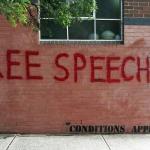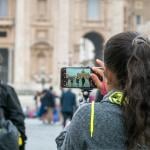Periodically in history, people get caught up in a cause that finds expression in destroying or getting rid of works of art. It happened in the early church. It happened in the Reformation. It is happening today as the revulsion against white nationalism is manifesting itself in the impulse to vandalize or remove statues of Confederate heroes. In this context, Luther’s response to the iconoclastic riots of his time is instructive.
Now when conservatives condemn certain public art works as offensive, they are told that art is supposed to be offensive. That isn’t true, as a general rule. But many of those who automatically defend erotic, violent, political, or blasphemous art are eager to censor 19th century military art. Ironically, they are saying exactly what conservatives say, that they find the works “offensive.” But isn’t art supposed to be offensive?
Most of those who are crusading against the Confederate statues do not consider them as art. They are “monuments”; that is, objects designed to honor their subjects. Just as the Reformation iconoclasts did not consider the images of saints they were smashing to be art. They considered them to be “idols.”
Indeed, our public monuments do have a resonance in our civil religion. They are secular objects that have an aura of the sacred. The Lincoln monument in Washington D.C. , magnificent and moving as it is, is an imitation of an ancient Greek temple: A structure outlined by classical columns. Inside is the image of the god.
The wonder is that Christians who are iconoclastic by their theology have not, as far as I know, objected to the temples to our national heroes/deities.
Civil religion, from a Christian point of view, is always idolatrous. The fault isn’t the works of art or the artists who made them, but the idolaters that look to the state, rather than to the true God, for all of their good, putting their faith in princes and in nations that pass away. Such idolatry continues even if the images that focus their devotion are taken away. But it is possible to love America, its constitution, and its heroes in a non-idolatrous way.
The monuments do express American values. There was a time when there was an effort to fold in Confederate values to those of the Union, bringing the nation back together in acts of reconciliation. But that arguably papered over the continued mistreatment of black people, as Jim Crow laws were subjugating the freed slaves yet again.
Iconoclastic movements have a way of starting small but then going out of control. With the Reformation, Christians who felt freed from the cults of the saints took down their statues in church and burned them. But then they started smashing the stained glass windows. Then they started burning crosses and icons of Christ. Then they destroyed the altars and church decorations. Then they began assaulting nuns and priests.
Similarly our current outbreak of iconoclasm started as a statement against slavery, targeting monuments to Confederate heroes like Robert E. Lee. But now some are demanding that we take down statues of George Washington–the Father of Our Country!– and Thomas Jefferson–who wrote that “all men are created equal”!–on the ground that they owned slaves.
Statues of Abraham Lincoln are also being vandalized. Whether that is being done by white nationalists in retaliation or by others caught up in anti-racist zeal is not clear. It is being brought up that Lincoln once said that the black race is inferior to the white race, which may well exclude the Great Emancipator, the man who freed the slaves, from public honor. His deeds are undone by his alleged thoughts.
The reality is that hardly any historical figure can measure up to today’s standards of rectitude. Shall we erase our history completely? Shall we forget that slavery existed? Shall we forget that we fought a civil war over the issue? If we get rid of every memory of slavery, wouldn’t that weaken the moral imperative of opposing racism? Victims of the Holocaust have taken a different course, insisting that the world “remember” their horrors, that we “never forget.”
Martin Luther, whose recovery of the Gospel and of the authority of Scripture was an inadvertent catalyst of the iconoclastic riots in Wittenberg, came out of hiding at Wartburg Castle, at great risk of his life, precisely to stop them.
Luther preached eight sermons that calmed things down. His main theme was that the Gospel bears fruit in love, not violence, destruction, and rioting. He also addressed the issues that people were fighting about and rioting over.
In his treatise Against the Heavenly Prophets in the Matter of Images and Sacraments, Luther directly addresses the iconoclastic controversy. He explains that the Biblical prohibition of making or worshipping “graven images” does not forbid art or even religious art, which was used extensively in the Tabernacle and Temple. Idolatry is having a false god, one that we make ourselves, a sin that does not require a physical object. He reasons that artistic images are permitted, just as we inevitably conceive of images in our minds whenever we think or read the Bible. (He thus connects art to imagination, a significant contribution.)
He agrees that we must not worship works of art, but they still can have a legitimate use. We should not pray to saints, he says, much less to the saint’s image. But the image can still have a historical use. It can remind us of what the saint did and inspire us to emulate the saint’s virtues.
Throughout, to summarize, Luther de-mystifies the images. They are works of art, not sacred totems.
He says that artistic images can have a historical significance. They can teach the historical events described in the Bible, and they can preserve the deeds of saints, great figures of the past, and events of the day.
Artistic images can be powerful in their effect on us, inspiring us to imitate the good deeds that they record.
How can this apply to today’s iconoclastic controversy? We can de-mystify the works in question. That would include not calling them “sacred” (as I have heard from their defenders). And also not giving them a power they do not have. They do not, for example, teach that slavery is OK, or that the Confederates were right in seceding, or that racism is justified. They are just statues.
We can use them for historical remembrance. This is what Robert E. Lee looked like. He was a great general. He led the armies of those who tried to destroy the union. He had qualms about slavery, but he defended it anyway. He was a complex person, who was admirable in some ways, wrong in other ways, and an important figure in American history.
We can let the artistic images move us, when they do, as long as the effect is virtuous. This statue of Robert E. Lee shows his resolve and courage before impossible odds. But he is a tragic figure. Like all tragic heroes, he is great, but his tragic flaw–his defense of slavery–brought his downfall and that of his cause. As in all tragedies, we can imitate the hero’s virtues while repudiating his flaw.
Luther also urged both sides in the iconoclastic controversies to consider “the weaker brethren.” Those, like him, who didn’t need images should respect those who did. And those who did needed to respect those who did not.
Painting: Destruction of Icons in Zurich, 1524, by Anonymous – “Panorama de la Renaissance” by Margaret Aston, Public Domain, https://commons.wikimedia.org/w/index.php?curid=12165690













